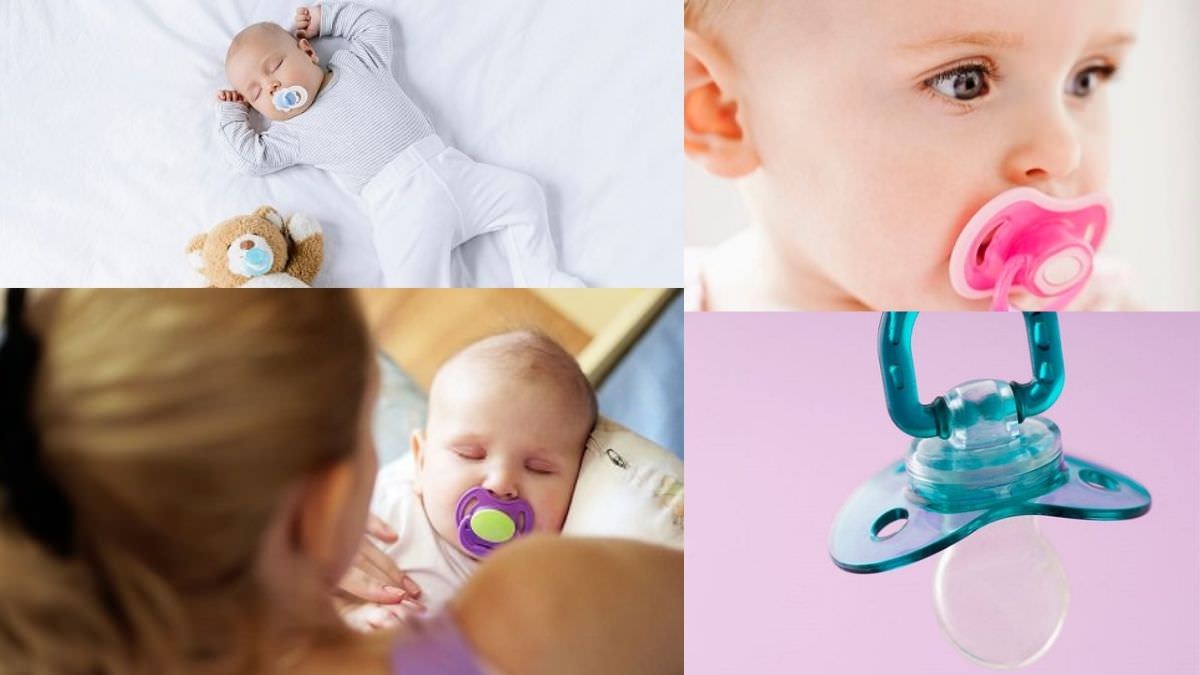One of our readers asked, “Should I Remove the Pacifier When the Baby is Sleeping?”. Find out the answer below!

A Pacifier is a nipple substitute for a baby to suck on between feedings. It is made of latex, silicone, or a blend of plastic and silicone. It usually consists of 3 parts, an elongated teat, a mouth guard that rests on the baby’s lips, and a handle.
The use of pacifiers for babies has been an ancient practice. The origin of the present-day pacifiers can be traced back to the end of the 19th century and the beginning of the 20th century. Babies have a sucking reflex. Even when they have full tummies, they need the comfort of sucking; hence, a pacifier fills this need.
Why and When to Introduce Pacifiers
For your newborn baby to feed successfully, he needs to have sucking, swallowing, and breathing skills. Pacifiers have a therapeutic effect on premature babies and babies who cannot bond with their mothers immediately after birth due to certain circumstances or medical conditions. You can decide whether or not to start the pacifier habit in your baby.
Make sure to start 3 or 4 weeks after your baby’s birth to establish a breastfeeding pattern and ensure good lactation. Otherwise, the baby may prefer the pacifier to the breast. You can give your baby the pacifier to soothe and comfort him between feeds. It is also possible that your baby may not take to the pacifier, which is perfectly alright, and there is no need to enforce the pacifier habit.
What Pacifiers To Choose

There are two types of pacifiers, the orthodontic ones in which the teat is shaped to conform to the baby’s mouth and its breastfeeding action. And the non-orthodontic pacifiers, which have a rounded bulb-like teat. The first type is conducive to the normal development of the baby’s teeth and mouth.
Pacifiers made of silicone are a good choice as they are more resilient, don’t retain odors, and are easier to clean. The latex pacifiers are softer than the silicone ones, but they are not sturdy, and they retain odors.
Should I Remove the Pacifier When the Baby is Sleeping?

The pacifier has been shown to reduce half the risk of babies dying from SIDS. So, let your baby sleep with the pacifier in his mouth. It will relax, soothe, and protect him/her.
Benefits of Using a Pacifier
- It can soothe your fussy baby and make him calm, which will help lower your stress too.
- It relaxes your baby, gives him a sense of security and comfort, and helps him fall asleep easier.
- Reduces crying spells and lowers your baby’s distress.
- During medical procedures or other stress-causing situations, a pacifier helps distract your baby.
- Reduces pain and discomfort.
- It reduces the risk of your baby dying from SIDS during his nap time or nighttime.
- Pacifier habit is easier to break in your baby than a thumb-sucking habit. Simply throw the pacifier away.
- Your baby cannot yawn or swallow on purpose to relieve ear pain caused by air pressure changes during flights. In such circumstances, pacifiers help.
- It helps premature babies to adapt to breastfeeding after tube feeding.
- Pacifiers provide the oral stimulation to develop the sucking reflex if your baby is a preterm or has low birth weight. It also helps develop a Neurobehavioral organization.
Disadvantages of using a pacifier:
- If you give your baby a pacifier in the first few weeks after birth, he may start to prefer it over breastfeeding. This will also affect your lactation.
- The incidence of ear infections is twice as high in children who use pacifiers than in those who do not use pacifiers.
- Your child may become dependent on their pacifier to fall asleep.
- An ill-maintained pacifier can become the source of infections in your child.
- If your baby is still using pacifiers after the age of two, it can affect his dentition, causing the teeth to tilt or slant. After the age of four, pacifiers have a lasting effect on teeth, which can also persist in adulthood.
Precautions When Using Pacifiers

- Choose good quality silicone pacifiers and a brand that has no BPA as they harbor fewer germs.
- Avoid using gel or liquid-filled pacifiers.
- Your baby might have a latex allergy; keep that in mind before choosing a pacifier made of latex.
- Opt for dishwasher safe, sturdy pacifiers that are made of 1 piece. Two-piece ones are unsafe as they might break or come off and turn into a choking hazard.
- Pick pacifiers, which are the right size for your baby’s mouth and age.
- Don’t secure the pacifier to your baby with a cord as it might be a strangling hazard.
- Do not apply any sweeteners to the pacifier.
- Wash the pacifier often in soap water and sterilize it between uses.
- Make sure the pacifier has ventilation holes on the mouthguard to let in air.
- Buy a new one if the pacifier gets damaged or develops cracks.
- Don’t use pacifiers as a first line of defense when your baby gets cranky or distressed.
- Do not use pacifiers for the long term as it may affect your baby’s speech development.
- Gently wean your baby off from pacifiers between 6 and 12 months of age. After six months, the risk of SIDS declines, and the risk of ear infection goes up. Start limiting pacifier use to sleep times.
- Any abrupt change can affect your baby’s stress levels, so try to wean him off pacifiers only when there are no other changes in his/her routine.
The benefits of using pacifiers outnumber its disadvantages, and you can introduce your baby to the pacifier habit if you take all the precautions and follow the guidelines for their use.



